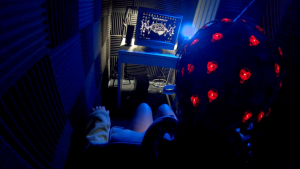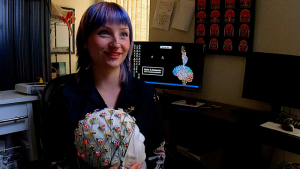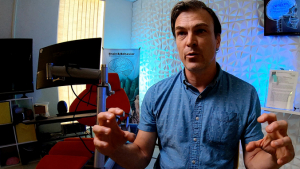From aiding in recovery for patients with neurologic damage to analyzing the long-term brain effects of COVID-19, the University of Hawaiʻi at Mānoa’s Brain and Behavior Lab is at the forefront of deepening our understanding of the brain and how it impacts our behaviors.

The lab features state-of-the-art equipment, including an 72-channel electroencephalograph that measures electrical activity in the brain; functional magnetic resonance imaging that measures brain activity by detecting changes in blood oxygenation; and transcranial direct current stimulation—low, direct current delivered via electrodes on the head to help patients with brain injuries or neuropsychiatric conditions.
The UH lab is also one of the first in the country to use new technology called optically pumped magnetometry, which gives researchers a sharper image of brain activity, which is critical when we want to understand the brain.
“Understanding how the mind works and finding better tools to measure how our minds and our brains are not performing is critical to be able to understand them and to be able to do something about it,” said Jonas Vibell, lab director and assistant professor in the Department of Psychology in the College of Social Sciences.
Investigating COVID-19 brain fog

Vibell’s team of approximately 10 students (undergraduate and graduate) are currently working on several projects, including one that is investigating the effects of COVID-19 on the brain. According to Vibell, many people who have contracted COVID-19 have reported experiencing brain fog. Through a nearly $40,000 grant from the UH Mānoa Social Science Research Institute, Vibell’s team will investigate the brain’s neuronal latencies to figure out why those who have contracted COVID-19 have reported experiencing brain fog. The researchers are currently recruiting volunteers to be part of the study. Anyone interested can email the lab through its website.
“It’s really exciting and it really feels like we’re on the forefront of science,” said Kyra GauthierDickey, a Brain and Behavior Lab member and UH Mānoa psychology PhD student. “Had I not been in this lab, I would have no idea that these kinds of fascinating projects are being created. To be able to work on something that has a local impact, it feels good.”
Cutting-edge research

Vibell also noted that studies of the brain have greatly influenced artificial intelligence (AI), where AI programming tries to mimic brain scans of how neurons are connected in the visual cortex (primary region of the brain that receives, integrates and processes visual information relayed from the retinas).
Aside from the COVID-19 study, GauthierDickey is focused on advancing classic brain experiments, such as the Posner Task that measures attention, into virtual reality. The UH Hilo alumna said that traditional lab experiments previously used 2D stimuli. She is interested in analyzing the results of 3D stimuli on human subjects to see how the added dimension is expressed in the brain.
“Even though we’re a small lab on Oʻahu, we do have a global impact and influence,” GauthierDickey said. “I think that Hawaiʻi can continue to grow as a scientific hub that’s internationally connected. I want to encourage everyone, especially our kamaʻāina, to explore their curiosity and interest in science.”
Community involvement
The Brain and Behavior Lab, which is located in both the UH Mānoa Biomedical Sciences building and Sakamaki Hall, partners with the UH Mānoa John A. Burns School of Medicine and the Queen’s Medical Center on research projects. Vibell’s team also regularly visits local high schools to get students involved in STEM research. And, as research projects require participants, Vibell encourages anyone from the general public to email the lab if they are interested in becoming part of a study.
“Just like computers get better every 10 years, so do brain cameras,” Vibell said. “We can see things much, much clearer than we used to and this enables us to answer some of the questions, even some of the questions that have been asked for thousands of years. Based on these new abilities to see things I think we stand before quite a revolution, and the impact that this will have in the next five to 10 years will be dramatic in many fields.”
—By Marc Arakaki

